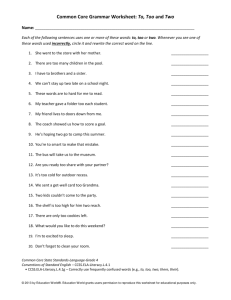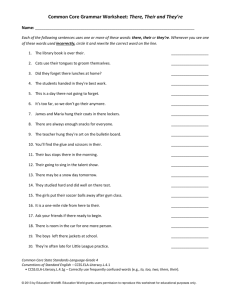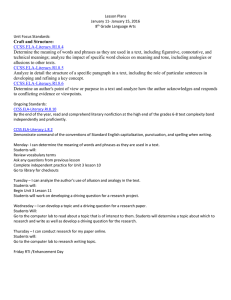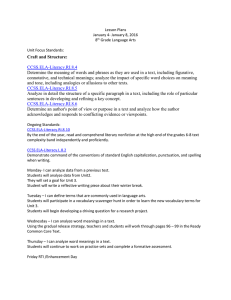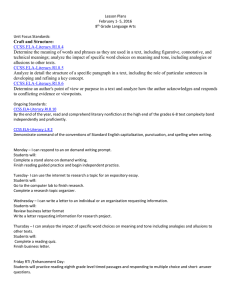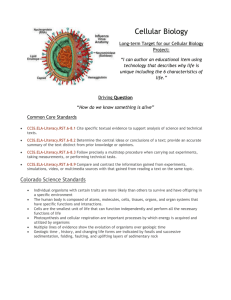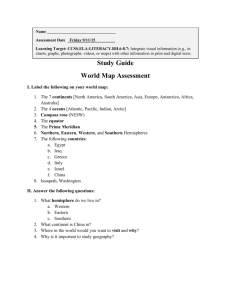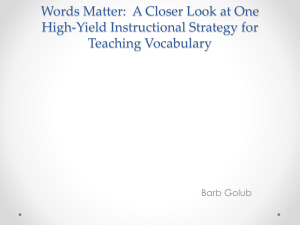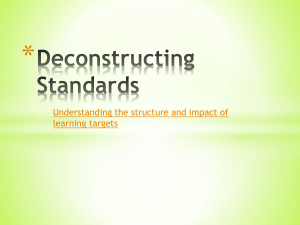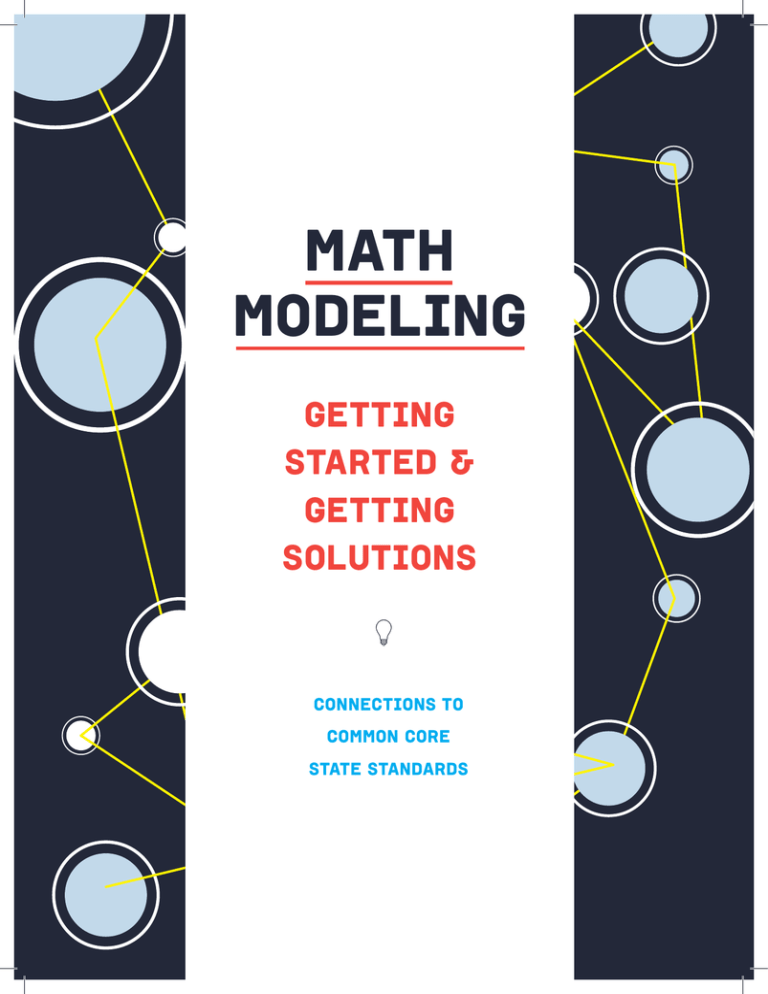
Math
Modeling
getting
started &
getting
solutions
connections to
common core
state standards
Publisher
Society for Industrial and Applied Mathematics (SIAM)
3600 Market Street, 6th Floor
Philadelphia, PA 19104-2688 USA
www.siam.org
funding provided by
The Moody’s Foundation in association with the Moody’s
Mega Math Challenge, the National Science Foundation
(NSF), and the Society for Industrial and Applied
Mathmatics (SIAM).
Authors
Karen M. Bliss
Department of Math & Computer Science,
Quinnipiac University, Hamden, CT
Kathleen R. Fowler
Department of Math & Computer Science,
Clarkson University, Potsdam, NY
Benjamin J. Galluzzo
Department of Mathematics,
Shippensburg University, Shippensburg, PA
design & Connections to
common core state standards
PlusUs
www.plusus.org
PRODUCTION
First Edition 2014
Printed and bound in the United States of America
No part of this guidebook may be reproduced or
stored in an online retrieval system or transmitted in
any form or by any means without the prior written
permission of the publisher. All rights reserved.
Connections between the
mathematical modeling
material present in math
modeling: getting started
& getting solutions can be
made to the Common Core
STATE Standards. connections
have been drawn within
the areAs of Mathematics,
English, and Science. The
standards with a star ( )
indicate a specific math
modeling standard as
defined by the Common Core.
1.
introduction
math
CCSS.Math.Content.HSF-IF.A.1
Understand that a function from one set (called the domain)
to another set (called the range) assigns to each element of the
domain exactly one element of the range. If f is a function and
x is an element of its domain, then f(x) denotes the output of f
corresponding to the input x. The graph of f is the graph of the
equation y = f(x).
CCSS.Math.Content.HSF-IF.A.2
Use function notation, evaluate functions for inputs in their
domains, and interpret statements that use function notation
in terms of a context.
CCSS.Math.Content.HSF-BF.A.1
Write a function that describes a relationship between two
quantities.
CCSS.Math.Content.HSF-LE.B.5
Interpret the parameters in a linear or exponential function in
terms of a context.
english
CCSS.ELA-Literacy.W.11-12.8 Gather relevant information from multiple authoritative
print and digital sources, using advanced searches effectively;
assess the strengths and limitations of each source in terms
of the task, purpose, and audience; integrate information into
the text selectively to maintain the flow of ideas, avoiding
plagiarism and overreliance on any one source and following
a standard format for citation.
science
CCSS.ELA-Literacy.RST.11-12.1 Cite specific textual evidence to support analysis of science
and technical texts, attending to important distinctions
the author makes and to any gaps or inconsistencies in the
account.
CCSS.ELA-Literacy.SL.11-12.1b Work with peers to promote civil, democratic discussions
and decision-making, set clear goals and deadlines, and
establish individual roles as needed.
CCSS.ELA-Literacy.SL.11-12.1c Propel conversations by posing and responding to questions
that probe reasoning and evidence; ensure a hearing for a
full range of positions on a topic or issue; clarify, verify, or
challenge ideas and conclusions; and promote divergent and
creative perspectives.
CCSS.ELA-Literacy.RST.11-12.7 Integrate and evaluate multiple sources of information
presented in diverse formats and media (e.g., quantitative
data, video, multimedia) in order to address a question or
solve a problem.
CCSS.ELA-Literacy.SL.11-12.1d Respond thoughtfully to diverse perspectives; synthesize
comments, claims, and evidence made on all sides of an
issue; resolve contradictions when possible; and determine
what additional information or research is required to
deepen the investigation or complete the task.
CCSS.ELA-Literacy.RST.11-12.9 Synthesize information from a range of sources (e.g., texts,
experiments, simulations) into a coherent understanding of
a process, phenomenon, or concept, resolving conflicting
information when possible.
CCSS.ELA-Literacy.SL.11-12.2 Integrate multiple sources of information presented in
diverse formats and media (e.g., visually, quantitatively,
orally) in order to make informed decisions and solve
problems, evaluating the credibility and accuracy of each
source and noting any discrepancies among the data.
CCSS.ELA-Literacy.SL.11-12.3 Evaluate a speaker’s point of view, reasoning, and use of
evidence and rhetoric, assessing the stance, premises, links
among ideas, word choice, points of emphasis, and tone
used.
CCSS.ELA-Literacy.RI.11-12.7 Integrate and evaluate multiple sources of information
presented in different media or formats (e.g., visually,
quantitatively) as well as in words in order to address a
question or solve a problem.
2
3
2.
defining
the
problem
statement
science
english
CCSS.ELA-Literacy.W.11-12.1a Introduce precise, knowledgeable claim(s), establish the
significance of the claim(s), distinguish the claim(s) from
alternate or opposing claims, and create an organization that
logically sequences claim(s), counterclaims, reasons, and
evidence.
CCSS.ELA-Literacy.W.11-12.1b Develop claim(s) and counterclaims fairly and thoroughly,
supplying the most relevant evidence for each while pointing
out the strengths and limitations of both in a manner that
anticipates the audience’s knowledge level, concerns, values,
and possible biases.
CCSS.ELA-Literacy.W.11-12.2a Introduce a topic; organize complex ideas, concepts, and
information so that each new element builds on that which
precedes it to create a unified whole; include formatting (e.g.,
headings), graphics (e.g., figures, tables), and multimedia
when useful to aiding comprehension
CCSS.ELA-Literacy.W.11-12.8 Gather relevant information from multiple authoritative
print and digital sources, using advanced searches effectively;
assess the strengths and limitations of each source in terms
of the task, purpose, and audience; integrate information into
the text selectively to maintain the flow of ideas, avoiding
plagiarism and overreliance on any one source and following
a standard format for citation
CCSS.ELA-Literacy.RST.11-12.1 Cite specific textual evidence to support analysis of science and
technical texts, attending to important distinctions the author
makes and to any gaps or inconsistencies in the account.
CCSS.ELA-Literacy.SL.11-12.1c Propel conversations by posing and responding to questions
that probe reasoning and evidence; ensure a hearing for a
full range of positions on a topic or issue; clarify, verify, or
challenge ideas and conclusions; and promote divergent and
creative perspectives.
CCSS.ELA-Literacy.RST.11-12.2 Determine the central ideas or conclusions of a text;
summarize complex concepts, processes, or information
presented in a text by paraphrasing them in simpler but still
accurate terms.
CCSS.ELA-Literacy.SL.11-12.1d Respond thoughtfully to diverse perspectives; synthesize
comments, claims, and evidence made on all sides of an
issue; resolve contradictions when possible; and determine
what additional information or research is required to
deepen the investigation or complete the task.
CCSS.ELA-Literacy.RST.11-12.7 Integrate and evaluate multiple sources of information
presented in diverse formats and media (e.g., quantitative data,
video, multimedia) in order to address a question or solve a
problem.
CCSS.ELA-Literacy.SL.11-12.2 Integrate multiple sources of information presented in
diverse formats and media (e.g., visually, quantitatively,
orally) in order to make informed decisions and solve
problems, evaluating the credibility and accuracy of each
source and noting any discrepancies among the data.
CCSS.ELA-Literacy.RST.11-12.9 Synthesize information from a range of sources (e.g., texts,
experiments, simulations) into a coherent understanding of
a process, phenomenon, or concept, resolving conflicting
information when possible.
CCSS.ELA-Literacy.SL.11-12.3 Evaluate a speaker’s point of view, reasoning, and use of
evidence and rhetoric, assessing the stance, premises, links
among ideas, word choice, points of emphasis, and tone
used.
CCSS.ELA-Literacy.RI.11-12.7 Integrate and evaluate multiple sources of information
presented in different media or formats (e.g., visually,
quantitatively) as well as in words in order to address a
question or solve a problem
CCSS.ELA-Literacy.SL.11-12.1b Work with peers to promote civil, democratic discussions and
decision-making, set clear goals and deadlines, and establish
individual roles as needed
4
5
3.
making
assumptions
math
CCSS.Math.Content.HSF-LE.A.1b
Recognize situations in which one quantity changes at a
constant rate per unit interval relative to another.
CCSS.Math.Content.HSF-LE.A.1c
Recognize situations in which a quantity grows or decays by a
constant percent rate per unit interval relative to another.
CCSS.Math.Content.HSF-LE.B.5
Interpret the parameters in a linear or exponential function in
terms of a context.
CCSS.Math.Content.HSS-IC.A.1
Understand statistics as a process for making inferences about
population parameters based on a random sample from that
population.
english
CCSS.ELA-Literacy.W.11-12.1 Write arguments to support claims in an analysis of
substantive topics or texts, using valid reasoning and relevant
and sufficient evidence.
CCSS.ELA-Literacy.W.11-12.2b Develop the topic thoroughly by selecting the most significant
and relevant facts, extended definitions, concrete details,
quotations, or other information and examples appropriate to
the audience’s knowledge of the topic.
CCSS.ELA-Literacy.W.11-12.9 Draw evidence from literary or informational texts to support
analysis, reflection, and research.
CCSS.ELA-Literacy.RI.11-12.7 Integrate and evaluate multiple sources of information
presented in different media or formats (e.g., visually,
quantitatively) as well as in words in order to address a
question or solve a problem.
6
science
CCSS.ELA-Literacy.SL.11-12.1a Come to discussions prepared, having read and researched
material under study; explicitly draw on that preparation
by referring to evidence from texts and other research on
the topic or issue to stimulate a thoughtful, well-reasoned
exchange of ideas.
CCSS.ELA-Literacy.RST.11-12.1 Cite specific textual evidence to support analysis of science
and technical texts, attending to important distinctions
the author makes and to any gaps or inconsistencies in the
account.
CCSS.ELA-Literacy.RST.11-12.7 Integrate and evaluate multiple sources of information
presented in diverse formats and media (e.g., quantitative data,
video, multimedia) in order to address a question or solve a
problem.
CCSS.ELA-Literacy.SL.11-12.1b Work with peers to promote civil, democratic discussions and
decision-making, set clear goals and deadlines, and establish
individual roles as needed.
CCSS.ELA-Literacy.SL.11-12.1c Propel conversations by posing and responding to questions
that probe reasoning and evidence; ensure a hearing for a
full range of positions on a topic or issue; clarify, verify, or
challenge ideas and conclusions; and promote divergent and
creative perspectives.
CCSS.ELA-Literacy.RST.11-12.9 Synthesize information from a range of sources (e.g., texts,
experiments, simulations) into a coherent understanding of
a process, phenomenon, or concept, resolving conflicting
information when possible.
CCSS.ELA-Literacy.SL.11-12.1d Respond thoughtfully to diverse perspectives; synthesize
comments, claims, and evidence made on all sides of an issue;
resolve contradictions when possible; and determine what
additional information or research is required to deepen the
investigation or complete the task.
CCSS.ELA-Literacy.SL.11-12.2 Integrate multiple sources of information presented in diverse
formats and media (e.g., visually, quantitatively, orally)
in order to make informed decisions and solve problems,
evaluating the credibility and accuracy of each source and
noting any discrepancies among the data.
CCSS.ELA-Literacy.SL.11-12.3 Evaluate a speaker’s point of view, reasoning, and use of
evidence and rhetoric, assessing the stance, premises, links
among ideas, word choice, points of emphasis, and tone used.
7
4.
defining
variables
math
english
science
CCSS.Math.Content.HSN-Q.A.1
Use units as a way to understand problems and to guide the
solution of multi-step problems; choose and interpret units
consistently in formulas; choose and interpret the scale and
the origin in graphs and data displays.
CCSS.ELA-Literacy.W.11-12.9 Draw evidence from literary or informational texts to support
analysis, reflection, and research.
CCSS.ELA-Literacy.RST.11-12.1 Cite specific textual evidence to support analysis of science and
technical texts, attending to important distinctions the author
makes and to any gaps or inconsistencies in the account.
CCSS.Math.Content.HSN-Q.A.2
Define appropriate quantities for the purpose of descriptive
modeling.
CCSS.Math.Content.HSN-Q.A.3
Choose a level of accuracy appropriate to limitations on
measurement when reporting quantities.
CCSS.Math.Content.HSA-CED.A.4
Rearrange formulas to highlight a quantity of interest, using
the same reasoning as in solving equations. For example,
rearrange Ohm’s law V = IR to highlight resistance R.
CCSS.Math.Content.HSF-LE.B.5
Interpret the parameters in a linear or exponential function in
terms of a context.
CCSS.ELA-Literacy.SL.11-12.1b Work with peers to promote civil, democratic discussions and
decision-making, set clear goals and deadlines, and establish
individual roles as needed.
CCSS.ELA-Literacy.RST.11-12.7 Integrate and evaluate multiple sources of information
presented in diverse formats and media (e.g., quantitative data,
video, multimedia) in order to address a question or solve a
problem.
CCSS.ELA-Literacy.SL.11-12.1c Propel conversations by posing and responding to questions
that probe reasoning and evidence; ensure a hearing for a
full range of positions on a topic or issue; clarify, verify, or
challenge ideas and conclusions; and promote divergent and
creative perspectives.
CCSS.ELA-Literacy.RST.11-12.9 Synthesize information from a range of sources (e.g., texts,
experiments, simulations) into a coherent understanding of
a process, phenomenon, or concept, resolving conflicting
information when possible.
CCSS.ELA-Literacy.SL.11-12.1d Respond thoughtfully to diverse perspectives; synthesize
comments, claims, and evidence made on all sides of an issue;
resolve contradictions when possible; and determine what
additional information or research is required to deepen the
investigation or complete the task.
CCSS.ELA-Literacy.SL.11-12.2 Integrate multiple sources of information presented in diverse
formats and media (e.g., visually, quantitatively, orally)
in order to make informed decisions and solve problems,
evaluating the credibility and accuracy of each source and
noting any discrepancies among the data.
CCSS.ELA-Literacy.SL.11-12.3 Evaluate a speaker’s point of view, reasoning, and use of
evidence and rhetoric, assessing the stance, premises, links
among ideas, word choice, points of emphasis, and tone used.
8
9
5.
building
solutions
CCSS.Math.Content.HSF-IF.B.4 For a function that models a relationship between two
quantities, interpret key features of graphs and tables in terms
of the quantities, and sketch graphs showing key features
given a verbal description of the relationship. Key features
include: intercepts; intervals where the function is increasing,
decreasing, positive, or negative; relative maximums and
minimums; symmetries; end behavior; and periodicity.
CCSS.Math.Content.HSF-IF.B.5
Relate the domain of a function to its graph and, where
applicable, to the quantitative relationship it describes. For
example, if the function h(n) gives the number of personhours it takes to assemble n engines in a factory, then the
positive integers would be an appropriate domain for the
function.
math
CCSS.Math.Content.HSF-IF.C.7
Graph functions expressed symbolically and show key features
of the graph, by hand in simple cases and using technology for
more complicated cases.
CCSS.Math.Content.HSA-REI.D.10
Understand that the graph of an equation in two variables is
the set of all its solutions plotted in the coordinate plane, often
forming a curve (which could be a line).
CCSS.Math.Content.HSF-IF.C.7a
Graph linear and quadratic functions and show intercepts,
maxima, and minima.
CCSS.Math.Content.HSA-REI.D.11
Explain why the x-coordinates of the points where the
graphs of the equations y = f(x) and y = g(x) intersect are
the solutions of the equation f(x) = g(x); find the solutions
approximately, e.g., using technology to graph the functions,
make tables of values, or find successive approximations.
Include cases where f(x) and/or g(x) are linear, polynomial,
rational, absolute value, exponential, and logarithmic
functions.
CCSS.Math.Content.HSF-IF.C.7b
Graph square root, cube root, and piecewise-defined
functions, including step functions and absolute value functions.
CCSS.Math.Content.HSF-IF.C.7c
Graph polynomial functions, identifying zeros when suitable
factorizations are available, and showing end behavior.
CCSS.Math.Content.HSF-IF.A.2 Use function notation, evaluate functions for inputs in
theirdomains, and interpret statements that use function
notation in terms of a context.
CCSS.Math.Content.HSF-IF.C.7d
Graph rational functions, identifying zeros and asymptotes
when suitable factorizations are available, and showing end
behavior.
CCSS.Math.Content.HSF-IF.A.3 Recognize that sequences are functions, sometimes defined
recursively, whose domain is a subset of the integers. For
example, the Fibonacci sequence is defined recursively by f(0)
= f(1) = 1, f(n+1) = f(n) + f(n-1) for n ≥ 1.
CCSS.Math.Content.HSF-IF.C.7e
Graph exponential and logarithmic functions, showing
intercepts and end behavior, and trigonometric functions,
showing period, midline, and amplitude.
10
CCSS.Math.Content.HSF-IF.C.8a
Use the process of factoring and completing the square in
a quadratic function to show zeros, extreme values, and
symmetry of the graph, and interpret these in terms of a
context.
full range of positions on a topic or issue; clarify, verify, or
challenge ideas and conclusions; and promote divergent and
creative perspectives.
CCSS.ELA-Literacy.SL.11-12.1d Respond thoughtfully to diverse perspectives; synthesize
comments, claims, and evidence made on all sides of an issue;
resolve contradictions when possible; and determine what
additional information or research is required to deepen the
investigation or complete the task.
CCSS.Math.Content.HSF-BF.A.1
Write a function that describes a relationship between two
quantities.
CCSS.Math.Content.HSF-LE.A.1
Distinguish between situations that can be modeled with
linear functions and with exponential functions.
CCSS.ELA-Literacy.SL.11-12.2 Integrate multiple sources of information presented in diverse
formats and media (e.g., visually, quantitatively, orally)
in order to make informed decisions and solve problems,
evaluating the credibility and accuracy of each source and
noting any discrepancies among the data.
CCSS.Math.Content.HSF-LE.A.1b
Recognize situations in which one quantity changes at a
constant rate per unit interval relative to another.
CCSS.Math.Content.HSF-LE.A.1c
Recognize situations in which a quantity grows or decays by a
constant percent rate per unit interval relative to another.
CCSS.ELA-Literacy.SL.11-12.3 Evaluate a speaker’s point of view, reasoning, and use of
evidence and rhetoric, assessing the stance, premises, links
among ideas, word choice, points of emphasis, and tone used.
CCSS.Math.Content.HSF-LE.B.5
Interpret the parameters in a linear or exponential function in
terms of a context.
science
CCSS.Math.Content.HSS-IC.B.6 Evaluate reports based on data.
english
CCSS.ELA-Literacy.RST.11-12.1 Cite specific textual evidence to support analysis of science and
technical texts, attending to important distinctions the author
makes and to any gaps or inconsistencies in the account.
CCSS.ELA-Literacy.W.11-12.6 Use technology, including the Internet, to produce, publish,
and update individual or shared writing products in
response to ongoing feedback, including new arguments or
information.
CCSS.ELA-Literacy.RST.11-12.3 Follow precisely a complex multistep procedure when carrying
out experiments, taking measurements, or performing
technical tasks; analyze the specific results based on
explanations in the text.
CCSS.ELA-Literacy.SL.11-12.1b Work with peers to promote civil, democratic discussions and
decision-making, set clear goals and deadlines, and establish
individual roles as needed.
CCSS.ELA-Literacy.RST.11-12.8 Evaluate the hypotheses, data, analysis, and conclusions in a
science or technical text, verifying the data when possible and
corroborating or challenging conclusions with other sources of
information.
CCSS.ELA-Literacy.SL.11-12.1c Propel conversations by posing and responding to questions
that probe reasoning and evidence; ensure a hearing for a
11
6.
analysis
& model
assessment
CCSS.Math.Content.HSA-CED.A.3 Represent constraints by equations or inequalities, and
by systems of equations and/or inequalities, and interpret
solutions as viable or nonviable options in a modeling
context. For example, represent inequalities describing
nutritional and cost constraints on combinations of different
foods.
CCSS.Math.Content.HSF-IF.A.2 Use function notation, evaluate functions for inputs in their
domains, and interpret statements that use function notation
in terms of a context.
CCSS.Math.Content.HSF-IF.B.4 For a function that models a relationship between two
quantities, interpret key features of graphs and tables in terms
of the quantities, and sketch graphs showing key features
given a verbal description of the relationship. Key features
include: intercepts; intervals where the function is increasing,
decreasing, positive, or negative; relative maximums and
minimums; symmetries; end behavior; and periodicity.
math
CCSS.Math.Content.HSF-IF.B.5 Relate the domain of a function to its graph and, where
applicable, to the quantitative relationship it describes. For
example, if the function h(n) gives the number of personhours it takes to assemble n engines in a factory, then the
positive integers would be an appropriate domain for the
function.
CCSS.Math.Content.HSN-Q.A.1 Use units as a way to understand problems and to guide the
solution of multi-step problems; choose and interpret units
consistently in formulas; choose and interpret the scale and
the origin in graphs and data displays.
CCSS.Math.Content.HSN-Q.A.2
Define appropriate quantities for the purpose of descriptive
modeling.
CCSS.Math.Content.HSF-LE.B.5 Interpret the parameters in a linear or exponential function in
terms of a context.
CCSS.Math.Content.HSA-CED.A.2 Create equations in two or more variables to represent
relationships between quantities; graph equations on
coordinate axes with labels and scales.
12
english
science
CCSS.ELA-Literacy.W.11-12.6 Use technology, including the Internet, to produce, publish,
and update individual or shared writing products in
response to ongoing feedback, including new arguments or
information.
CCSS.ELA-Literacy.RST.11-12.1 Cite specific textual evidence to support analysis of science and
technical texts, attending to important distinctions the author
makes and to any gaps or inconsistencies in the account.
CCSS.ELA-Literacy.SL.11-12.1b Work with peers to promote civil, democratic discussions and
decision-making, set clear goals and deadlines, and establish
individual roles as needed.
CCSS.ELA-Literacy.RST.11-12.3 Follow precisely a complex multistep procedure when carrying
out experiments, taking measurements, or performing
technical tasks; analyze the specific results based on
explanations in the text.
CCSS.ELA-Literacy.SL.11-12.1c Propel conversations by posing and responding to questions
that probe reasoning and evidence; ensure a hearing for a
full range of positions on a topic or issue; clarify, verify, or
challenge ideas and conclusions; and promote divergent and
creative perspectives.
CCSS.ELA-Literacy.SL.11-12.1d Respond thoughtfully to diverse perspectives; synthesize
comments, claims, and evidence made on all sides of an issue;
resolve contradictions when possible; and determine what
additional information or research is required to deepen the
investigation or complete the task.
CCSS.ELA-Literacy.SL.11-12.2 Integrate multiple sources of information presented in diverse
formats and media (e.g., visually, quantitatively, orally)
in order to make informed decisions and solve problems,
evaluating the credibility and accuracy of each source and
noting any discrepancies among the data.
CCSS.ELA-Literacy.SL.11-12.3 Evaluate a speaker’s point of view, reasoning, and use of
evidence and rhetoric, assessing the stance, premises, links
among ideas, word choice, points of emphasis, and tone used.
13
7.
putting
it all
together
math
CCSS.Math.Content.HSN-Q.A.1 Use units as a way to understand problems and to guide the
solution of multi-step problems; choose and interpret units
consistently in formulas; choose and interpret the scale and
the origin in graphs and data displays.
CCSS.Math.Content.HSN-Q.A.2 Define appropriate quantities for the purpose of descriptive
modeling.
CCSS.Math.Content.HSN-Q.A.3 Choose a level of accuracy appropriate to limitations on
measurement when reporting quantities.
english
CCSS.ELA-Literacy.W.11-12.1d Establish and maintain a formal style and objective tone while
attending to the norms and conventions of the discipline in
which they are writing.
CCSS.ELA-Literacy.W.11-12.1e Provide a concluding statement or section that follows from
and supports the argument presented.
CCSS.ELA-Literacy.W.11-12.5 Develop and strengthen writing as needed by planning,
revising, editing, rewriting, or trying a new approach, focusing
on addressing what is most significant for a specific purpose
and audience. (Editing for conventions should demonstrate
command of Language standards 1–3 up to and including
grades 11–12 here.)
CCSS.ELA-Literacy.W.11-12.2 Write informative/explanatory texts to examine and convey
complex ideas, concepts, and information clearly and
accurately through the effective selection, organization, and
analysis of content.
CCSS.ELA-Literacy.W.11-12.6 Use technology, including the Internet, to produce, publish,
and update individual or shared writing products in
response to ongoing feedback, including new arguments or
information.
CCSS.ELA-Literacy.W.11-12.2c Use appropriate and varied transitions and syntax to link the
major sections of the text, create cohesion, and clarify the
relationships among complex ideas and concepts.
CCSS.ELA-Literacy.W.11-12.7 Conduct short as well as more sustained research projects
to answer a question (including a self-generated question)
or solve a problem; narrow or broaden the inquiry when
appropriate; synthesize multiple sources on the subject,
demonstrating understanding of the subject under
investigation.
CCSS.ELA-Literacy.W.11-12.2d Use precise language, domain-specific vocabulary, and
techniques such as metaphor, simile, and analogy to manage
the complexity of the topic.
CCSS.ELA-Literacy.W.11-12.2e Establish and maintain a formal style and objective tone while
attending to the norms and conventions of the discipline in
which they are writing.
CCSS.ELA-Literacy.W.11-12.2f Provide a concluding statement or section that follows from
and supports the information or explanation presented (e.g.,
articulating implications or the significance of the topic.
CCSS.ELA-Literacy.W.11-12.4 Produce clear and coherent writing in which the development,
organization, and style are appropriate to task, purpose, and
audience. (Grade-specific expectations for writing types are
defined in standards 1–3 above.)
CCSS.ELA-Literacy.SL.11-12.2 Integrate multiple sources of information presented in diverse
formats and media (e.g., visually, quantitatively, orally) in order
to make informed decisions and solve problems, evaluating
the credibility and accuracy of each source and noting any
discrepancies among the data.
CCSS.ELA-Literacy.SL.11-12.3 Evaluate a speaker’s point of view, reasoning, and use of
evidence and rhetoric, assessing the stance, premises, links
among ideas, word choice, points of emphasis, and tone used.
CCSS.ELA-Literacy.SL.11-12.4 Present information, findings, and supporting evidence,
conveying a clear and distinct perspective, such that listeners
can follow the line of reasoning, alternative or opposing
perspectives are addressed, and the organization, development,
substance, and style are appropriate to purpose, audience, and a
range of formal and informal tasks.
CCSS.ELA-Literacy.SL.11-12.5 Make strategic use of digital media (e.g., textual, graphical,
audio, visual, and interactive elements) in presentations to
enhance understanding of findings, reasoning, and evidence
and to add interest.
CCSS.ELA-Literacy.SL.11-12.1b Work with peers to promote civil, democratic discussions and
decision-making, set clear goals and deadlines, and establish
individual roles as needed.
CCSS.ELA-Literacy.SL.11-12.6 Adapt speech to a variety of contexts and tasks, demonstrating
a command of formal English when indicated or appropriate.
(See grades 11–12 Language standards 1 and 3 here for specific
expectations.)
CCSS.ELA-Literacy.SL.11-12.1c Propel conversations by posing and responding to questions
that probe reasoning and evidence; ensure a hearing for a
full range of positions on a topic or issue; clarify, verify, or
challenge ideas and conclusions; and promote divergent and
creative perspectives.
science
CCSS.ELA-Literacy.SL.11-12.1d Respond thoughtfully to diverse perspectives; synthesize
comments, claims, and evidence made on all sides of an issue;
resolve contradictions when possible; and determine what
additional information or research is required to deepen the
investigation or complete the task.
CCSS.ELA-Literacy.RST.11-12.1 Cite specific textual evidence to support analysis of science and
technical texts, attending to important distinctions the author
makes and to any gaps or inconsistencies in the account.
CCSS.ELA-Literacy.W.11-12.1c Use words, phrases, and clauses as well as varied syntax to link
the major sections of the text, create cohesion, and clarify the
relationships between claim(s) and reasons, between reasons
and evidence, and between claim(s) and counterclaims.
14
15
notes
notes
16
17
3600 Market Street, 6th Floor
Philadelphia, PA 19104-2688 USA
www.siam.org

